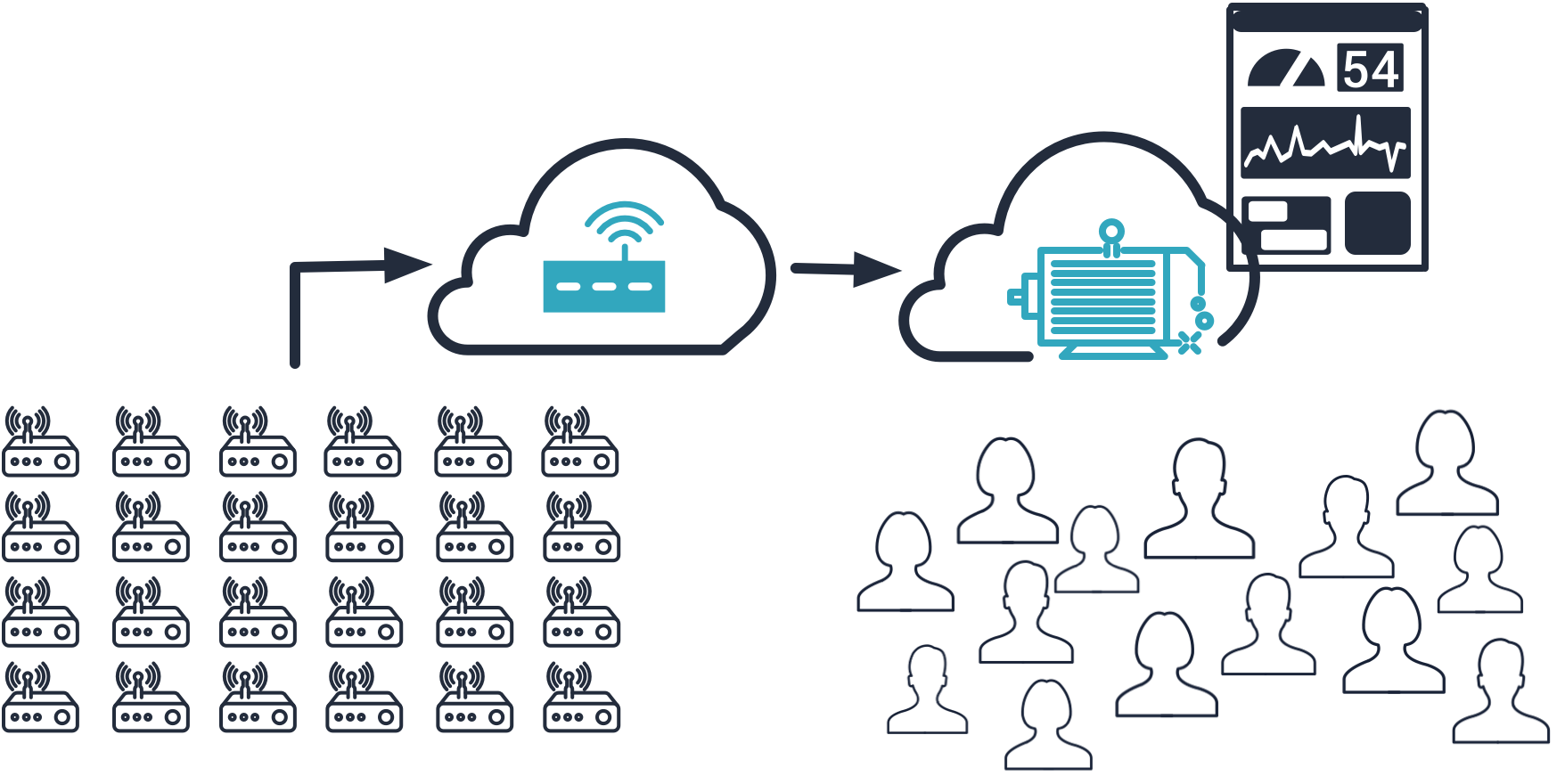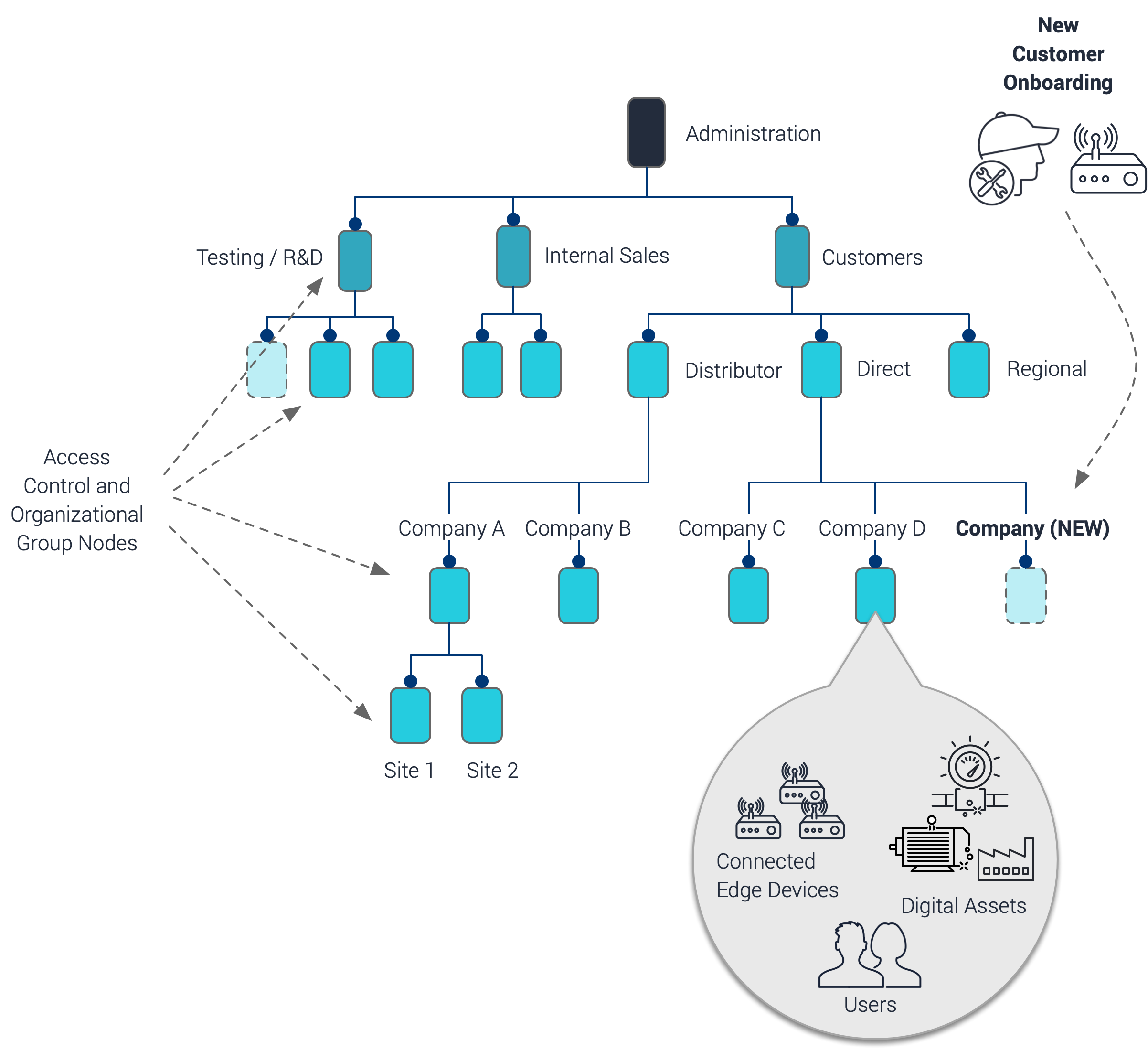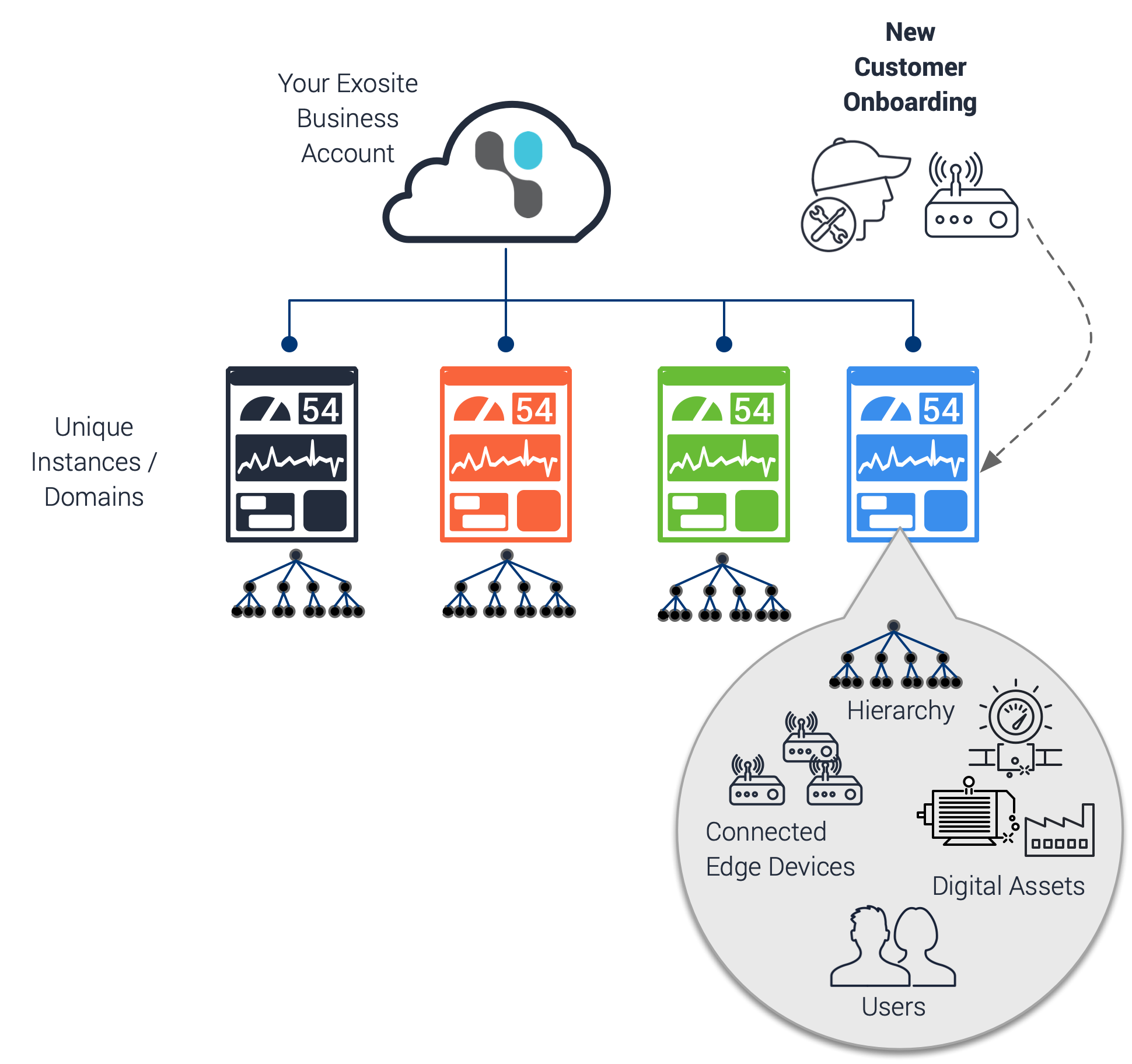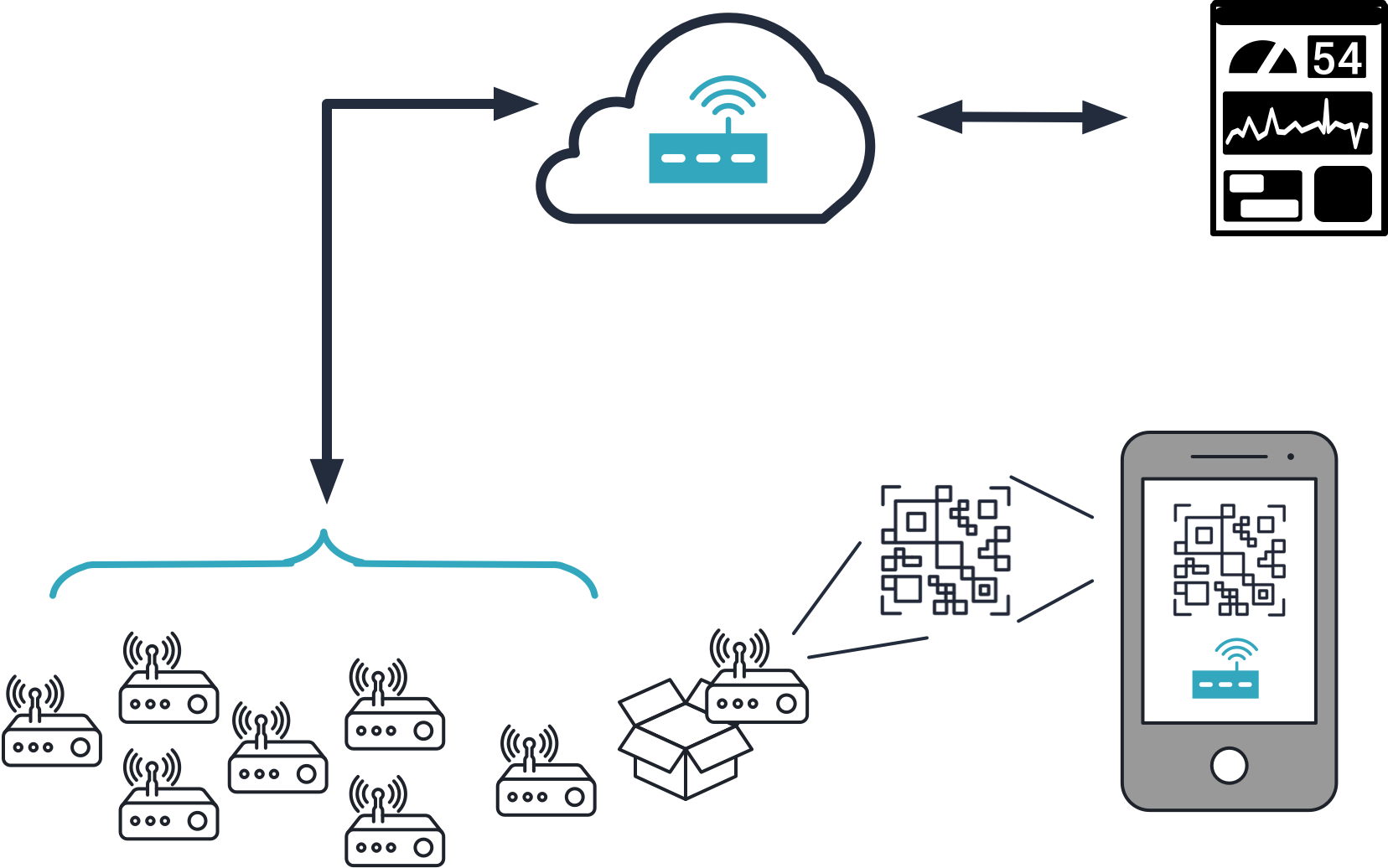Multi-Customer Deployment Models for Connected Solution Companies
by Mike Aanenson, on January 7, 2021
To support the different needs and requirements of each of your customers, it's important to have a variety of onboarding options without the burden of custom development. Exosite provides the flexibility solution providers need to quickly onboard new customers and begin generate recurring revenue.
At Exosite, we often work with companies that sell connected solutions to other businesses. These solution companies are known by a few different names -- original equipment manufacturers (OEMs), value-added resellers (VARs), integrators, or consultants. But they all typically sell hardware (e.g., edge gateways, sensors, wireless sensors, controls) that they either manufacture or distribute on behalf of another manufacturer.

As these companies look to offer "Connected Solutions" to their customers, there are different models they can use to scale their solution and onboard individual customers. The deployment, onboarding, and cost structure for these customers will depend on how they have built their application or who they have partnered with for their Internet of Things (IoT) platform.
Common Challenges
When we begin working with an OEM/VAR/integrator customer, most have faced similar challenges as they attempted to build and scale a connected solution either by licensing software from a vendor or building the solution themselves. As you consider the path you may take in developing a connected solution, it is important to understand the common hurdles you may face with each approach.
Per Site Software Licensing
One common approach is to utilize IoT and application software that can be licensed or used as a service (i.e., SaaS). However, it's important to keep in mind that many require additional fees per unique customer site. Some even require your customer to sign an agreement directly with that provider.
Although this may sound harmless, the result is that you and your customers can become locked into expensive up-front costs, expensive long-term recurring costs, and a set ecosystem that may not be a good fit for you. You also run the risk of losing the relationship with your end customer, who is now directly engaged with that software vendor.
When considering this path, ensure you fully understand how your chosen software provider handles charges for things like adding customers, devices, and unique customer sites. Even if their pricing is feasible in the beginning, make sure it will also work in the future as your solution grows and you onboard new customers. If it won't, it may be time to consider another provider.
Building a Solution
Building a custom connected solution on top of cloud services is another common approach that allows you to develop something that fits your exact needs. But most organizations don't have a large development and IT/DevOps team, meaning this type of effort is complicated, expensive, and time consuming. In our experience, customers generally spend at least two years developing a minimal viable product.
Why so long? Designing, developing, and delivering an application is a significant effort in and of itself. There is also a non-trivial amount of functionality your solution must incorporate in order to support growth, including:
- Support to easily onboard new customers via an administrator or self sign-up
- The ability for your support team to manage issues without requiring the help of IT/DevOps ($$) each time
- The ability to scale economically
- A way to allow users to claim their devices for ownership or allow admins to assign ownership
- User access controls and user authentication
- The ability for customization to fit the different needs of individual customers without requiring one-off development
- The ability to add functionality continuously as customers requirements change (software becomes stale quickly)
When considering this path, ensure you fully understand the time and development resources it may take to get to this point. For many organizations, it often makes more sense to select a solution that is ready to go from day one.
What Exosite Provides
Exosite has been helping customers successfully develop connected solutions for a variety of industries for over ten years. With this experience, we've developed a unique expertise that we've incorporated into both our products and our approach. So, how do we compare to the two common paths above?
- First, Exosite is a SaaS provider, but we take a dramatically different approach to pricing than most other vendors. Our ExoSense® application is a remote condition monitoring solution that provides real-time data visualization about the health of machines and equipment. ExoSense includes clear start-up costs, predictable long-term pricing, and has a variety of deployment and onboarding options that include additional customer sites at no additional cost (we'll explain more below).
- Second, ExoSense provides everything you need to get started today, so you can skip the effort it takes to build out basic functionality. Instead, you can focus on adding value by customizing the solution to incorporate your unique industry expertise. As a result, you can begin onboarding new customers right away and feel confident about scaling as you grow. And, most importantly, you can begin generating recurring revenue immediately.
Want to know more? In the following sections, we highlight the different deployment models ExoSense provides to fit the type of customers you may have or want to support.
Approach 1: Multi-Customer ExoSense Instance
This first model can be thought of as a multi-tenant solution. It takes advantage of ExoSense's group hierarchy, which allows you to build groups and subgroups (many levels deep) that not only represent your customers, but group them by region and/or support model. In addition, customers themselves can create subgroups for things like divisions, sites, and groups of assets at a site.
This group hierarchy in ExoSense is based on Graph Theory, which represents the relationship between nodes. When new users are invited, they are placed at a node in the group hierarchy and assigned a role that defines their permissions. They are only able to see digital assets, dashboards, and data in their assigned group and child groups.

Using this capability, you may onboard hundreds or thousands of customer businesses within one ExoSense instance. To learn more, see this article about Exosite's group hierarchy functionality.
Approach 2: Unique ExoSense Instances for Individual Customers
With an Exosite business account, you may deploy many instances of ExoSense. Larger customers may require their own custom domain, custom branding, and higher-level administration, which can be achieved with their own instance. In this mode, your account would begin to have many separate ExoSense applications running, each with a unique URL, set of users, set of assets, etc. As the administrator, you manage the billing, enabling of edge IoT Connectors available, and additional integrations.

Approach 3: Hybrid Onboarding
It's rare that either of these approaches will fit all customers. With an Exosite account, you can support both. In this way, you would have one ExoSense application with your branding for multi-customer use, but also have additional unique instances of ExoSense for larger customers.
Edge IoT Device Ownership
In the consumer market, smart-home products are bought by a home owner and installed with a process to register or 'claim' the device as their own. In the industrial and commercial space, a need to define ownership exists, but is a bit more complicated because the connected hardware and generated data are owned by an organization, not one person. ExoSense natively supports the concept that a connected device is assigned to a group node, representing an organization or site or individual that you want to handle data access. Devices can be assigned ownership by an administrator or by using a claiming method that can include a claim code or QR code. This claiming functionality is enabled by Exosite's EveryCloud technology for device makers.

What if You Don't Want to Sell Software?
Selling software, especially in a recurring model, adds complexity to your business and may not make sense for everyone. Companies that want to sell hardware to end customers but not sell software have the ability to partner with Exosite for referral purposes, which still gives you a way to present a solution to your customer, in addition to promoting your hardware products or services.
Please contact us for further information on partnerships and referral engagements. Additionally, talk to us about adding an IoT Connector for your hardware to our IoT marketplace for immediate use with ExoSense.
In Summary
Scaling an IoT solution from a proof of concept for one customer to a production-ready solution that can onboard and support hundreds or thousands of customers can be complex, both technically and from a business perspective. Whether you choose to work with Exosite, build your own solution, or work with another software provider, it's important to understand the challenges of each approach and plan how your solution will scale, who will support it, and how you will onboard customers.
If you are interested in discussing your business and go-to-market models for a connected solution offering, please set up a meeting with our team.



